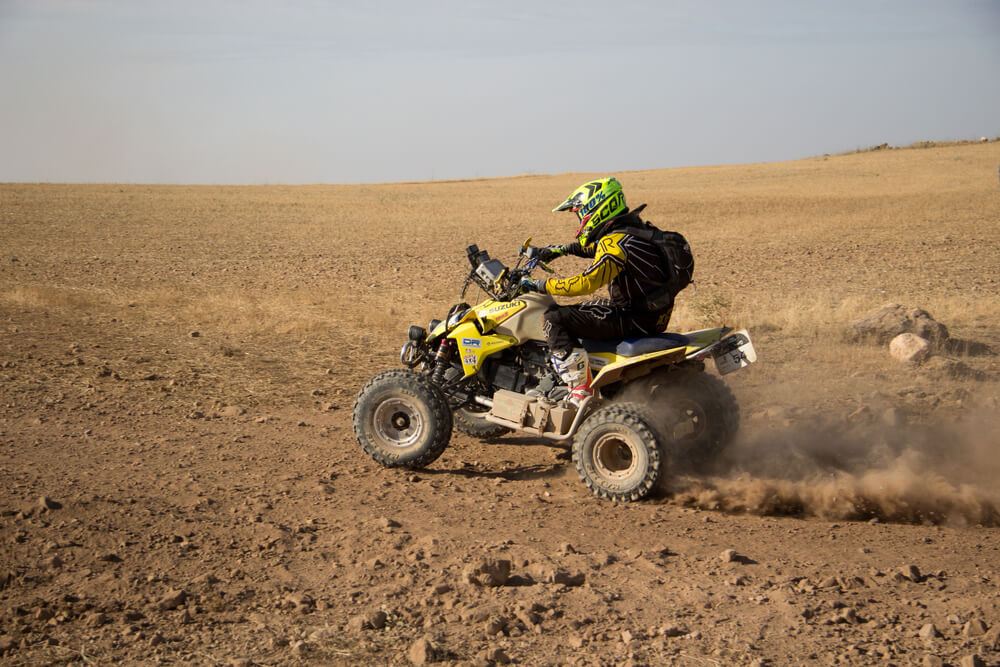All-terrain vehicles (ATVs) are versatile machines designed for adventure and thrills. As an ATV enthusiast, you might be constantly searching for ways to optimize your ride’s performance and speed.
Luckily, there are ways to customize your ATV to go faster without breaking the bank. This article will discuss some of the most effective methods to enhance your ATV’s speed while ensuring its safety and reliability on the track or trail.
Understanding your ATV’s power and capabilities is crucial before you dive into modifications. By learning the ins and outs of your machine, you’ll be able to make informed decisions on which upgrades and customizations will best suit your riding style and terrain.
From improving the exhaust system to upgrading the suspension, tweaking your ATV’s performance can lead to a more enjoyable and thrilling experience.
Safety should be a top priority when making modifications to your ATV. It’s important to consider the potential risks and precautions associated with enhancing your machine’s speed.
Proper maintenance and a thorough understanding of your ATV’s limits will greatly reduce the chances of accidents or damage to your vehicle.
With the right combination of upgrades and know-how, you’ll be well on your way to a faster, more enjoyable ride.
Key Takeaways
- Customize your ATV for improved speed by understanding its power and capabilities.
- Effective modifications include upgrading the exhaust system and suspension.
- Prioritize safety and maintenance when enhancing your ATV for increased speed.
Ways to Customize Your ATV to Go Faster

As an ATV owner, you may want to increase your vehicle’s speed and performance. To achieve this, it’s important to understand the power of your ATV.
In this section, we will discuss some fundamental concepts, such as horsepower and torque, and how to make changes to enhance your ATV’s performance.
One key concept is horsepower, which measures the amount of work your engine can perform. It’s directly influenced by the torque and engine RPM. The more horsepower your ATV has, the faster it can go.
One way to increase horsepower is by installing a big bore kit, which enhances both horsepower and torque.
Another essential factor is torque, the force generated by the engine to power your ATV. A higher torque can lead to faster acceleration and improved pulling power.
By maximizing torque, you can improve your ATV’s overall performance. One method to increase torque and horsepower is turbocharging the engine.
Airflow also plays a crucial role in your ATV’s performance. By optimizing airflow, you can increase an engine’s efficiency and power output. Upgrading your air filter to a high-flow filter can help enhance airflow, leading to a boost in performance.
Fuel delivery is another vital aspect to consider in enhancing your ATV’s power. An efficient Electronic Fuel Injection (EFI) system can lead to better throttle response and more consistent power delivery, further improving your ATV’s performance.
Lastly, making changes like adding wheel spacers can improve handling, cornering, and overall comfort while riding your ATV. These modifications contribute to a safer and more efficient off-roading experience.
By understanding your ATV’s power and making appropriate modifications, you can customize your vehicle to go faster and perform better on various terrains.
Remember to research and choose the right combination of improvements that suit your needs and riding style.
Modifying the Exhaust System
One way to customize your ATV for better performance is by modifying the exhaust system. Upgrading the exhaust can result in improved horsepower, lighter weight, and a throaty sound that announces your presence on the trails.
Let’s discuss a few aspects of modifying the exhaust system for better speed and performance.
First, consider getting a high-quality aftermarket exhaust. These systems generally offer greater flow capacity and quality materials, allowing your engine to breathe more efficiently. This can result in a noticeable improvement in performance.
When selecting an exhaust system, look for one designed specifically for your ATV model to ensure optimal compatibility and performance.
Second, understand the difference between slip-on exhausts and full-system exhausts. A slip-on exhaust is a more affordable option, replacing only the muffler section of your stock system. This can give you some improvement in performance and weight reduction.
On the other hand, a full-system exhaust replaces the entire stock exhaust from the header to the muffler, providing more significant improvements in horsepower and weight reduction, though at a higher cost.
Lastly, pay attention to the material of the exhaust system. Lightweight materials such as titanium or aluminum can help reduce the overall weight of your ATV, improving acceleration and top speed.
Nevertheless, these materials can be more expensive than stainless steel or other heavier options. Balancing the cost and weight reduction is essential when choosing an exhaust system for your ATV.
By upgrading your exhaust system, you can efficiently improve your ATV’s performance, giving you more speed and power on your off-road adventures.
Remember, it’s important to carefully research and select the right exhaust system for your specific ATV model and budget to ensure maximum benefits.
Upgrading the Suspension

Upgrading your ATV’s suspension is a crucial step to make it go faster and perform better. A properly-tuned suspension can greatly impact handling, comfort, and overall ride quality.
Let’s explore some modifications you can make to achieve this.
First, consider adjusting your shocks. Adjusting shock settings can help you find the balance between comfort and performance. If you’re looking to maximize speed, a stiffer suspension will provide better control and response in high-speed situations, while a softer setting will deliver a smoother, more comfortable ride.
In addition to optimizing the shock settings, it is essential to have the correct preload for your weight and riding style. To adjust the preload, start by lifting the front and rear of your ATV and loosening the locking rings on both front and rear shocks.
Make sure the settings are identical for a balanced suspension. Keep in mind that increasing preload effectively stiffens the suspension while decreasing it softens the ride.
If you want to go a step further, consider investing in performance shocks. Upgraded shocks can provide better control, response, and adjustability. Brands like Axis offer custom shock options, including coil spring and air shocks, which are designed to suit your specific riding style and requirements.
Another effective upgrade is changing the ATV’s stance. A wider stance helps improve stability and handling in demanding conditions, such as high-speed cornering. To achieve a wider stance, consider using wheel spacers or wider aftermarket wheels.
Be mindful of your ATV’s specifications and legal requirements before making any significant alterations to its width.
By following these tips and making the necessary modifications, you can enhance your ATV’s suspension system, ultimately improving its speed and overall performance. Remember to prioritize safety and make sure all changes are compliant with your ATV’s specifications and local regulations.
Tuning the Carburetor
To get better performance and speed out of your ATV, you must ensure that the carburetor is properly adjusted. This section will provide you with some essential tips on re-jetting and cleaning the carburetor to optimize your ATV’s performance.
Re-Jetting the Carburetor
Re-jetting your carburetor involves changing the size of the jet, which controls the amount of fuel and air mixture entering the engine. If your ATV is bogging down or experiencing difficulty at full throttle, it could be an indication that the jetting is off.
- Remove the Carburetor: First, remove the carburetor from your ATV according to the owner’s manual. Find it under the seat or airbox in most models.
- Replace the Jets: Once you’ve removed the carburetor, disassemble it to access the jets. There are typically two jets: the main jet and the pilot jet. Replace them with larger or smaller jets according to your tuning needs.
- Test and Adjust: After you’ve replaced the jets, reassemble the carburetor and re-install it on your ATV. Test the ATV’s performance and make any fine adjustments as necessary to achieve the desired air-fuel mixture and throttle response.
Cleaning the Carburetor
A clean carburetor ensures efficient performance and can also directly affect your ATV’s speed. Regular maintenance and cleaning of the carburetor helps prevent dirt and debris from affecting the fuel and air mixture.
- Remove the Carburetor: Similar to re-jetting, start by removing the carburetor from your ATV as per your owner’s manual.
- Disassemble and Inspect: Disassemble the carburetor and inspect the jets, floats, and other components for dirt, debris, or wear. Make a note of any parts that seem worn or damaged.
- Clean the Components: Use a carburetor cleaner to clean the jets, floats, and other components of the carburetor. Make sure to remove any buildup or residue that could obstruct the fuel and airflow.
- Reassemble and Reinstall: Once all the components are clean and dry, reassemble the carburetor and reinstall it on your ATV. Test the performance to confirm that the cleaning has improved your ATV’s speed and efficiency.
Enhancing the Air Intake

A reliable way to boost your ATV’s performance is by enhancing the air intake. Upgrading your ATV’s air intake system to a high-quality one can significantly increase horsepower and torque. This can be done through a few simple steps.
First, consider installing an aftermarket air filter to replace the stock filter. Aftermarket filters usually have increased air flow which allows your ATV’s engine to breathe better. They are also typically made of better materials, extending their lifespan and making them more efficient in trapping dirt and debris.
Second, optimize the airbox by removing any excess restrictions. This can include removing the snorkel or air silencer and making sure your airbox is clean and free of unnecessary obstructions. This provides a more direct path for air to flow into your engine.
Lastly, consider upgrading to a performance-oriented intake system. This type of system is designed to provide maximum airflow to your engine, further enhancing its performance. Some popular options include cold air intakes and short ram intake systems.
Remember that a well-tuned air intake system is essential for optimal performance. When upgrading your air intake, ensure it is compatible with your ATV make and model. Always follow the manufacturer’s instructions for installation and maintenance to ensure your air intake system remains efficient and effective.
Increasing the Gear Ratio
One effective way to make your ATV go faster is by increasing its gear ratio. This can be achieved by modifying the front and rear sprockets. In this section, we will discuss the process of altering these sprockets to maximize your ATV’s speed.
Changing the Front Sprocket
To increase your ATV’s gear ratio, you can start by changing the front sprocket. By replacing the stock front sprocket with a smaller one, you can effectively increase the gear ratio. This means that your ATV will benefit from faster acceleration, making it more agile off the line.
Regardless, it is essential to keep in mind that this modification can result in a slight reduction of your top speed.
When selecting a new front sprocket, it is crucial to consider the number of teeth. By decreasing the teeth count, you can efficiently increase your gear ratio.
For example, if your stock front sprocket has 14 teeth, consider switching to a 13-tooth sprocket to increase the gear ratio without sacrificing too much top speed.
Alter the Rear Sprocket
Another option for increasing your gear ratio is to modify the rear sprocket. Unlike the front sprocket, you can achieve this by swapping the stock rear sprocket with a larger one. This will increase your ATV’s acceleration even more, allowing for quicker takeoffs.
Similar to the front sprocket, it is essential to observe the number of teeth when selecting a new rear sprocket. By increasing the teeth count, the gear ratio will become higher.
For instance, if your stock rear sprocket has 36 teeth, consider upgrading to a 38-tooth sprocket to boost the acceleration and overall performance.
When customizing your ATV’s gear ratio, it is important to strike a balance between acceleration and top speed to suit your specific riding style and terrain.
By carefully selecting and modifying the front and rear sprockets, you can enhance your ATV’s performance, making it faster and more enjoyable to ride.
Installing a Nitrous Oxide Kit

When you’re looking to give your ATV a significant speed boost, installing a nitrous oxide kit is a popular and effective option. Nitrous oxide (NOS) systems add more oxygen to your engine’s combustion chamber, allowing it to burn more fuel and produce more power.
In this section, we will guide you through the steps to install a nitrous oxide kit on your ATV.
Before starting the installation, it’s important to choose the right NOS system for your ATV. Consider factors such as the type of kit (wet or dry), the delivery method (single nozzle, direct port, plate, or bar), and compatibility with your ATV’s engine. For most ATVs, a single nozzle system is suitable.
Once you’ve obtained the correct nitrous oxide kit for your ATV, begin the installation by mounting the NOS tank securely in a suitable location. Ensure it’s accessible for refilling and that the mounting position allows for appropriate routing of the delivery pipes.
Next, route the nitrous supply line from the tank to the engine. Be cautious to avoid any sharp edges or heat sources that could damage the line. Ensure the line is secured and won’t interfere with any moving parts on your ATV.
Now, it’s time to install the nitrous nozzle into the intake. Depending on your ATV’s intake material, you may need to drill and tap a hole in the intake or use the supplied collar and nut in case of a rubber intake. Be sure to use Teflon paste on the threads to prevent leakages.
After the nozzle is installed, connect the nitrous supply line and any additional wiring for activation switches or solenoids as per the kit instructions. Ensure all electrical connections are secure and protected from moisture, heat, and vibrations.
Finally, it’s essential to test the system for leaks and proper functionality. Start your ATV, activate the nitrous system, and carefully observe the engine while it’s running. If everything is operating as expected and there are no leaks or abnormal behavior, your nitrous oxide kit is successfully installed.
Keep in mind that using nitrous oxide puts additional stress on your ATV’s engine components, so always follow the manufacturer’s recommendations for proper maintenance and usage. Enjoy the increased power and performance of your ATV, but remember to ride safely and responsibly.
Routine ATV Maintenance
Maintaining your ATV regularly is critical for its longevity and performance. Keeping up with basic tasks will ensure your ride runs smoothly and helps you get more speed out of your machine.
In this section, we will discuss two essential maintenance tasks: Regular Oil Changes and Tire Pressure Checks.
Regular Oil Changes
Changing your ATV’s oil is a crucial part of its maintenance routine. The engine oil lubricates, cools, and preserves the engine’s internal components, ensuring smooth operation.
When the oil becomes dirty or contaminated, it can cause increased wear on the engine and decrease performance.
It’s recommended that you check your ATV’s oil levels at least every few rides and change the oil according to the manufacturer’s guidelines. Different ATVs have varying oil change intervals, so consult your owner’s manual for specific recommendations for your vehicle.
Keeping the oil clean and at the proper level will help maintain your ATV’s engine power and improve its overall speed.
Tire Pressure Check
Tire pressure is another essential aspect of your ATV’s performance. Properly inflated tires can improve traction, handling, and overall speed, while underinflated or overinflated tires can negatively impact performance.
Consistently checking the tire pressure ensures that your ATV is operating with optimal efficiency.
Before each ride, inspect your tires visually for any damage or punctures and use a tire pressure gauge to measure the pressure. Make sure your tires are inflated to the manufacturer’s recommended specifications, which you can find in your owner’s manual.
If necessary, adjust the tire pressure to reach the optimal level. By keeping your tire pressure in check, you will enhance your ATV’s performance and ensure a faster, more enjoyable ride.
Safety Measures and Precautions

When customizing your ATV to go faster, it’s crucial to prioritize safety. After all, increased speed can also increase the risk of accidents.
In this section, we’ll cover some essential safety measures and precautions you should consider while making modifications.
First and foremost, always wear the appropriate safety gear. This includes a helmet, goggles, gloves, boots, and protective clothing. The right gear can significantly decrease the risk of injury in the event of an accident.
Next, be sure to regularly inspect your ATV, especially after making modifications. Check the tire pressure and look for signs of wear on the tires and rims. This will help ensure optimal performance and safety on challenging terrains.
If you opt to install performance-enhancing components like a big bore kit, remember that additional power may require adjustments to the ATV’s suspension and brakes. This is particularly important because better handling and stopping power become even more crucial at higher speeds.
Learning to ride safely and responsibly at your ATV’s enhanced speed is equally important. Take the time to familiarize yourself with its new capabilities, gradually increasing your speed and handling as you feel more comfortable.
Finally, when riding with others, be sure to practice trail etiquette by yielding to descending traffic and announcing your intent before passing. Slowing down for other riders also promotes a safer environment for everyone.
By keeping these safety measures and precautions in mind, you can enjoy your faster ATV while minimizing the potential risks that come with increased speed.
Frequently Asked Questions
How can I increase my ATV’s horsepower?
To increase your ATV’s horsepower, you can consider options like upgrading the air filter, installing a performance exhaust system, and utilizing a fuel controller. Additionally, you can install a big bore kit to enhance the horsepower and torque for better acceleration and top speed.
What performance mods are available for ATVs?
There are various performance mods available for ATVs, such as upgrading the air filter, changing tire size, weight, and pressure, and installing a nitrous kit. Other modifications include adjusting the throttle limiter screw, upgrading the exhaust system, and altering the gear ratio to optimize speed and performance.
Are there ATV big bore kits to boost speed?
Yes, ATV big bore kits are available for various off-road vehicles, and they can significantly increase your ATV’s engine displacement, horsepower, and torque. These kits typically involve replacing the piston, cylinder, and sometimes the camshaft, ultimately leading to better acceleration and top speed.
How can I adjust throttle limiter screw for faster speed?
Adjusting the throttle limiter screw on your ATV allows you to control the maximum throttle opening, thus affecting the top speed. By loosening the screw, you can increase the throttle opening and potentially achieve a higher top speed.
Nonetheless, it’s essential to consider safety factors before making changes to the throttle limiter, as it might impact the overall control of your ATV.
What steps to make a UTV go faster?
To make your UTV go faster, you can follow similar steps as customizing an ATV, including upgrading the air filter, changing the tire size, weight, and pressure, installing a performance exhaust system, and altering the gear ratio. Additionally, consider installing a big bore kit or a nitrous kit to enhance your UTV’s horsepower and torque for better performance.
Are there options to make a 200cc ATV faster?
Yes, there are several options to make a 200cc ATV faster. Consider upgrading the air filter, adjusting the throttle limiter screw, and changing the gear ratio to optimize speed.
Installing a performance exhaust system can also help improve speed, and in some cases, a big bore kit may be compatible with your 200cc ATV to increase power. Always consult your ATV’s manual or a professional mechanic before making modifications to ensure compatibility and safety.














